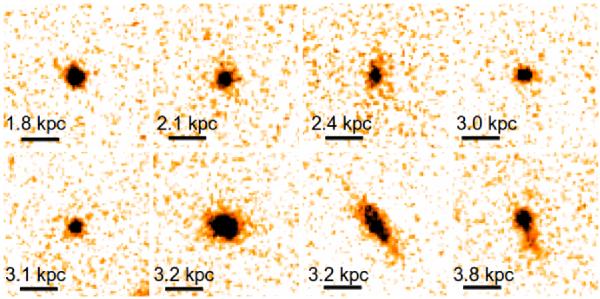We report the discovery of 31 low-luminosity (−14.5 ≳ MAB(B) ≳ −18.8), extreme emission line galaxies (EELGs) at 0.2 ≲ z ≲ 0.9identified by their unusually high rest-frame equivalent widths (100 ≤ EW[O iii] ≤ 1700 Å) as part of the VIMOS Ultra Deep Survey (VUDS).

HST F814W-band imagery of EELGs in the COSMOS and ECDF fields covered by VUDS. Each postage stamp is 2′′ on a side.
VIMOS optical spectra of unprecedented sensitivity (IAB ~ 25 mag) along with multiwavelength photometry and HST imaging are used to investigate spectrophotometric properties of this unique sample and to explore, for the first time, the very low stellar mass end (M⋆ ≲ 108M⊙) of the luminosity-metallicity (LZR) and mass-metallicity (MZR) relations at z < 1. Characterized by their extreme compactness (R50 < 1 kpc), low stellar mass and enhanced specific star formation rates (sSFR = SFR/M⋆ ~ 10-9−10-7 yr-1), the VUDS EELGs are blue dwarf galaxies likely experiencing the first stages of a vigorous galaxy-wide starburst. Using Te-sensitive direct and strong-line methods, we find that VUDS EELGs are low-metallicity (7.5 ≲ 12 + log (O/H) ≲ 8.3) galaxies with high ionization conditions (log (qion) ≳ 8 cm s-1), including at least three EELGs showing Heiiλ 4686 Å emission and four extremely metal-poor (≲10% solar) galaxies. The LZR and MZR followed by VUDS EELGs show relatively large scatter, being broadly consistent with the extrapolation toward low luminosity and mass from previous studies at similar redshift. However, we find evidence that galaxies with younger and more vigorous star formation – as characterized by their larger EWs, ionization and sSFR – tend to be more metal poor at a given stellar mass.
The full paper can be found in Amorín et al. 2014, A&A, 568, 8
